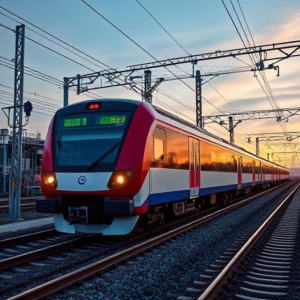What Are Advanced Communication Systems for Trains?
In simple terms, advanced communication systems are the tools and technologies that allow trains, stations, and control centers to talk to each other and share important information. Think of it like a super-smart network that helps everything run smoothly and safely in the railway system.
These systems are not just about talking between the train and the station, but also involve a lot of high-tech tools like radios, computers, and sensors that help manage train movements, safety, and even customer services.

Key Parts of Advanced Communication Systems:
- Train-to-Ground Communication
- What is it? This is the communication between the train and control centers on the ground. It allows the train operator (or even automated systems) to get instructions about signals, track conditions, and other important info.
- How it works: The train uses radio signals or data connections (like 4G/5G networks) to stay in touch with control centers. These systems can send real-time updates about train speed, location, and even potential issues on the track.
- Why it’s important? It ensures that the train operator can safely follow instructions and that control centers can monitor trains in real time, making it easier to prevent accidents and delays.
- Train-to-Train Communication
- What is it? This communication happens between trains running on the same track or in the same network.
- How it works: Trains can send signals to each other, like telling a nearby train about its position or speed. This is especially useful in busy networks, where multiple trains are running close to each other.
- Why it’s important? It helps avoid accidents by making sure trains know where each other are. It also allows trains to adjust speed or stop if needed to prevent collisions.
- Automatic Train Control (ATC) and Train Protection Systems
- What is it? These are systems that use advanced communication to control a train’s speed and ensure it follows safety rules automatically, without relying on the driver for everything.
- How it works: The system constantly monitors things like the train’s speed, track conditions, and signals. If a train is going too fast or if there’s a danger up ahead, the system can automatically slow it down or stop it.
- Why it’s important? It reduces human error, making the system much safer, especially in emergency situations.
- Real-Time Data and Monitoring
- What is it? Trains today send tons of data back to control centers, like information on speed, location, fuel usage, and even how the train is performing mechanically.
- How it works: The train collects data from sensors (e.g., brakes, wheels, engines) and sends it via wireless networks to a central system that tracks the health of the train and its progress.
- Why it’s important? This helps prevent issues by catching problems early. For example, if a train’s brakes are starting to wear down, the system can alert the operators to fix it before something serious happens.
- Passenger Communication Systems
- What is it? These systems are for communicating with passengers, providing them with updates and important information during the journey.
- How it works: The train may have displays, loudspeakers, or even apps that inform passengers about the next station, delays, safety instructions, or other announcements.
- Why it’s important? It improves the passenger experience by making sure people are informed and can travel more comfortably and safely.
- Onboard Wi-Fi and Connectivity
- What is it? Many modern trains offer onboard internet so passengers can stay connected during their journey.
- How it works: Trains use satellite links or 4G/5G mobile networks to provide internet to passengers, allowing them to browse the web, stream media, or work.
- Why it’s important? It keeps passengers entertained or productive while traveling and makes the train ride more enjoyable.
- Global Positioning System (GPS)
- What is it? GPS is used to track the exact location of the train in real-time.
- How it works: Satellites help track the train’s position, and this information is sent back to the control center. This can help schedule train arrivals, improve safety, and ensure timely travel.
- Why it’s important? It allows the control center to know exactly where every train is at any moment, which is crucial for managing schedules and avoiding accidents.
Why Are These Communication Systems Important?
- Safety: Communication systems help ensure that trains know exactly where they are, what signals are ahead, and if there are any problems on the tracks. They can prevent accidents by giving operators (or the automated systems) important information to stop or slow down when needed.
- Efficiency: These systems help manage the flow of trains, avoid congestion, and make the best use of available tracks, ensuring trains run on time and with minimal delays.
- Passenger Experience: With systems that update passengers about arrivals, delays, and train conditions, traveling becomes smoother and more comfortable.
- Real-Time Monitoring: Control centers can monitor the health of the trains, track usage, and even detect mechanical problems early, helping avoid costly repairs and ensuring a safe journey.
Examples of Communication Systems in Action:
- CBTC (Communication-Based Train Control): This is a system used in metro networks. It ensures that trains run safely by continuously communicating with the track and adjusting train speeds automatically.
- ETCS (European Train Control System): This system is used in Europe and helps with train control and communication across countries, ensuring trains run safely and efficiently even when crossing borders.
- Wi-Fi on Trains: Many high-speed trains, like those in Europe and Asia, provide passengers with Wi-Fi, enhancing the travel experience.
Conclusion:
Advanced communication systems for trains are like the nervous system of a railway. They help everything stay connected, running smoothly, and safely. Whether it’s real-time data, automatic train control, or passenger updates, these systems are critical to ensuring the efficiency, safety, and comfort of modern train travel.
Keywords: Communication Systems, Railway











